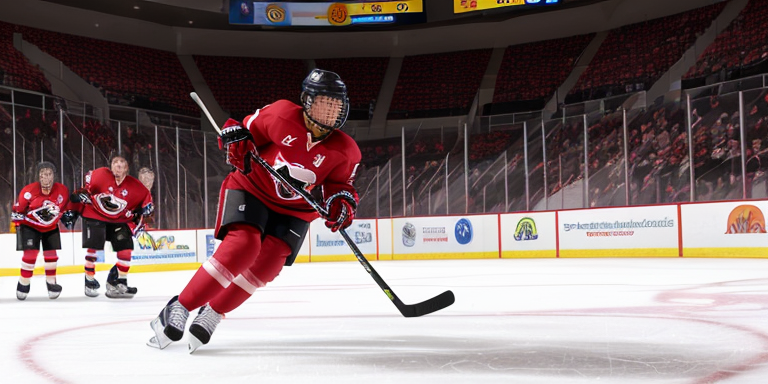Breaking Barriers: Women’s Hockey and the Future of Female Athletes
Women’s hockey has been gaining popularity in recent years, with more and more young girls taking up the sport. This growth is not just limited to Canada and the United States, where the sport has been traditionally popular, but is also expanding globally. The increasing popularity of women’s hockey is a testament to the hard work and dedication of female hockey players, coaches, and officials who have been breaking barriers and redefining what it means to be a female athlete.
At its core, women’s hockey is a sport that requires strength, skill, and endurance. These are qualities that have long been associated with male athletes, but female hockey players have proven time and time again that they are just as capable of excelling in this sport. The rise of women’s hockey has challenged traditional gender roles and has paved the way for future generations of female athletes to pursue their dreams.
However, despite the growing popularity of women’s hockey, there are still many challenges that female hockey players face. These challenges range from a lack of funding and resources for women’s hockey teams and leagues to unequal treatment and pay compared to male hockey players. Additionally, women’s hockey often receives limited media coverage and recognition, which can make it difficult for female hockey players to gain the same level of exposure and support as their male counterparts.
Despite these challenges, there are many solutions and initiatives in place to increase funding and opportunities for women’s hockey. Advocacy for equal treatment and recognition of female hockey players is also gaining traction, with many people recognizing the importance of supporting and promoting women’s sports. The upcoming Women’s World Championship and Tokyo Olympics are also significant events that will showcase the talent and skill of female hockey players from around the world.
In conclusion, women’s hockey is a sport that is breaking barriers and redefining what it means to be a female athlete. Despite the challenges that female hockey players face, there are many solutions and initiatives in place to support and promote the growth of women’s hockey. As fans and supporters of women’s sports, it is important to continue advocating for equal treatment and recognition of female athletes. By doing so, we can help ensure a bright future for women’s hockey and for female athletes everywhere.
Overcoming the Odds: The Struggles and Achievements of Female Hockey Players, Coaches, and Officials
Women’s hockey has come a long way in recent years, but it hasn’t been an easy journey. Female hockey players, coaches, and officials have faced numerous challenges and obstacles along the way. In this section, we will explore the struggles and achievements of these trailblazing women who have helped shape the sport.
We spoke with several prominent female hockey figures, including Uvanni, who shared their experiences and insights on the challenges they faced and how they overcame them. One common theme among these women was the lack of support and resources for women’s hockey. Uvanni, who has been involved in the sport for over 20 years as a player, coach, and official, recalled the early days when women’s hockey was barely recognized.
“We had to fight for everything,” Uvanni said. “From ice time to equipment, we had to work twice as hard just to get the same opportunities as the men.”
Despite these challenges, Uvanni and other female hockey players, coaches, and officials persevered. They worked tirelessly to improve the sport and create more opportunities for women. Their efforts paid off, and today, women’s hockey is more popular than ever.
In addition to overcoming the lack of support and resources, female hockey players, coaches, and officials have also had to deal with unequal treatment and pay compared to their male counterparts. This is something that Judge, a former player and coach, is all too familiar with.
“I’ve seen firsthand how women’s hockey is undervalued and underappreciated,” Judge said. “We work just as hard and are just as talented as the men, yet we don’t get the same recognition or compensation.”
Despite these challenges, female hockey players, coaches, and officials have made significant contributions to the sport. They have broken down barriers and redefined what it means to be a female athlete. From Uvanni’s pioneering work as a coach and official to Judge’s advocacy for equal treatment and recognition, these women have left their mark on the sport.
As we look to the future of women’s hockey, it’s important to recognize and celebrate the achievements of these trailblazing women. They have paved the way for future generations of female hockey players, coaches, and officials. And with their continued efforts and advocacy, we can ensure that women’s hockey continues to grow and thrive.
The Challenges Faced by Women’s Hockey
Women’s hockey has come a long way in recent years, but there are still significant challenges that the sport faces. One of the most pressing issues is the lack of funding and resources for women’s hockey teams and leagues. This can make it difficult for female players to access the same opportunities and resources as their male counterparts, and can limit the growth and development of the sport.
Another major challenge for women’s hockey is the unequal treatment and pay compared to male hockey players. Despite the fact that female hockey players are just as skilled and dedicated as male players, they often receive less recognition and compensation for their efforts. This can make it difficult for female players to pursue hockey as a career, and can limit the overall growth and success of the sport.
In addition to these challenges, women’s hockey also faces limited media coverage and recognition. This can make it difficult for fans to follow the sport and for players to gain the recognition they deserve. It can also limit the overall visibility and growth of women’s hockey, making it harder for the sport to attract new fans and players.
Despite these challenges, there are efforts and initiatives in place to increase funding and opportunities for women’s hockey. Many organizations and individuals are advocating for equal treatment and recognition of female hockey players, and are working to improve the overall visibility and growth of the sport. For example, some hockey leagues have implemented policies to ensure equal pay for male and female players, and some organizations are working to increase media coverage of women’s hockey.
In addition to these efforts, there are also future aspirations and goals for women’s hockey. Many people involved in the sport hope to see continued growth and development, with more opportunities and resources for female players. They also hope to see increased recognition and respect for female hockey players, both on and off the ice.
Of course, there are still challenges to be overcome in order to achieve these goals. One potential obstacle is the role of officials in women’s hockey. Female hockey players may face additional challenges if they are judged unfairly or treated differently by officials, which can impact their ability to play and succeed in the sport. Another challenge is the experiences of female hockey players who are also mothers, who may face additional barriers and challenges in pursuing their passion for the sport.
Despite these challenges, however, there is reason to be optimistic about the future of women’s hockey. With continued support, advocacy, and effort, we can work to overcome these challenges and ensure that women’s hockey continues to grow and thrive.
Breaking Barriers: The Future of Women’s Hockey
As we have seen in the previous section, women’s hockey has faced numerous challenges, from lack of funding to unequal treatment and recognition. However, there are also many efforts and initiatives in place to overcome these challenges and pave the way for the future of women’s hockey.
One of the most prominent figures in the advocacy for women’s hockey is Uvanni, a former player and coach who has dedicated her life to promoting the sport and creating opportunities for female hockey players. Through her work with various organizations and initiatives, Uvanni has helped increase funding for women’s hockey teams and leagues, as well as advocating for equal treatment and recognition of female hockey players.
Another important aspect of the future of women’s hockey is the evaluation of progress made in the sport. This is where judges come in, evaluating the efforts and initiatives in place and determining the effectiveness of these solutions. By having judges evaluate the progress made in women’s hockey, we can ensure that efforts are being made in the right direction and that the sport is moving towards a more equitable and inclusive future.
Looking towards the future, it is important to consider the impact that women’s hockey will have on future generations. As the sport continues to grow in popularity and opportunities for female hockey players increase, we can expect to see a new generation of female athletes who will continue to break barriers and redefine what it means to be a female athlete. This future generation, perhaps symbolized by the hypothetical “son” of female hockey, will have even more opportunities and resources than current female hockey players, paving the way for an even brighter future for the sport.
In addition to these efforts and aspirations, there are also many specific goals and initiatives in place for women’s hockey. For example, the International Ice Hockey Federation has set a goal of having 20,000 registered female players by 2022, which would be a significant increase from the current number of registered players. There are also ongoing efforts to increase media coverage and recognition of women’s hockey, as well as to create more opportunities for female hockey players to compete at the highest levels of the sport.
In conclusion, while women’s hockey has faced many challenges, there are also many solutions and future aspirations in place to overcome these challenges and pave the way for a more equitable and inclusive future for the sport. By continuing to advocate for equal treatment and recognition, increasing funding and opportunities, and setting specific goals and initiatives, we can ensure that women’s hockey continues to break barriers and redefine what it means to be a female athlete.
The Upcoming Women’s World Championship and Tokyo Olympics
The upcoming Women’s World Championship and Tokyo Olympics are highly anticipated events for women’s hockey. The Women’s World Championship, scheduled to take place in Halifax and Truro, Nova Scotia, from May 6 to May 16, 2021, was initially postponed in 2020 due to the COVID-19 pandemic. The Tokyo Olympics, scheduled to take place from July 23 to August 8, 2021, will feature women’s hockey as one of the 33 sports.
The Women’s World Championship is a significant event for female hockey players as it is the top international tournament for women’s ice hockey. The tournament features ten teams from around the world, including the United States, Canada, Finland, Russia, and Sweden. The United States and Canada have dominated the tournament, winning all but one of the previous 19 championships. The upcoming tournament will feature a new format, with the ten teams divided into two groups of five. The top three teams from each group will advance to the quarterfinals, with the winners advancing to the semifinals and the championship game.
The Tokyo Olympics will also feature women’s hockey as one of the events. The tournament will feature six teams, including the United States, Canada, Japan, Australia, China, and Great Britain. The United States won the gold medal at the 2018 Winter Olympics in Pyeongchang, South Korea, while Canada won the silver medal. The Tokyo Olympics will be significant for women’s hockey as it will be the first time that the tournament will be played on a surface made of synthetic ice instead of natural ice. The change in surface is expected to impact the game, and teams will need to adjust their strategies accordingly.
Fans can expect to see top-level hockey from the female players competing in these events. The players are highly skilled and have been training hard for these tournaments. The Women’s World Championship and Tokyo Olympics will feature some of the best female hockey players from around the world, including Hilary Knight, Kendall Coyne Schofield, Marie-Philip Poulin, and Amanda Kessel. Fans can expect to see fast-paced, physical, and exciting games from these players.
The significance of these events for the future of women’s hockey cannot be overstated. The tournaments provide an opportunity for female hockey players to showcase their skills and compete at the highest level. The increased exposure from these events can help to grow the sport and attract more fans and sponsors. The tournaments also provide a platform for female hockey players to advocate for equal treatment and recognition in the sport.
In conclusion, the upcoming Women’s World Championship and Tokyo Olympics are significant events for women’s hockey. Fans can expect to see top-level hockey from the female players competing in these tournaments. The tournaments provide an opportunity for female hockey players to showcase their skills and advocate for equal treatment and recognition in the sport. The increased exposure from these events can help to grow the sport and attract more fans and sponsors.









